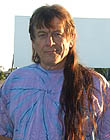|
|
This topic comprises 3 pages: 1 2 3
|
|
Author
|
Topic: How popular is 16mm
|
|
|
John Pytlak
Film God

Posts: 9987
From: Rochester, NY 14650-1922
Registered: Jan 2000
|
 posted 08-01-2004 11:18 PM
posted 08-01-2004 11:18 PM





The use of 16mm prints is certainly declining, due to the "convenience" of video.
But 16mm color negative film volume is growing, as Super-16 has become a popular origination format for HDTV and lower budget features:
http://www.kodak.com/go/16mm
quote:
With 16 mm film, you've got it made.
Creatively, technologically, and economically, our state-of-the-art stocks deliver greater flexibility, and control than ever before. Discover why 16 mm film is the perfect choice for your next project.
http://www.kodak.com/US/en/motion/16mm/why/?id=0.1.4.3&lc=en
quote:
Kodak introduced 16 mm motion picture film and equipment in 1923 as an inexpensive amateur alternative to the 35 mm film format. Compared with 35 mm film, the 16 mm format offers advantages such as smaller, less-expensive cameras and lower film stock and developing costs. Because of these factors, the 16 mm format was quickly adopted for professional news reporting, corporate, and educational applications.
| IP: Logged
|
|
|
|
|
|
|
|
|
|
|
|
|
|
|
|
|
|
Frank Angel
Film God

Posts: 5305
From: Brooklyn NY USA
Registered: Dec 1999
|
 posted 08-03-2004 12:24 PM
posted 08-03-2004 12:24 PM





quote: Edward Jurich
Even though the film runs at a slower feet-per-minute speed, the optical track can sound quite good on a high quality pickup and stereo is possible
Coulda, woulda, shoulda. IF ONLY: 16mm is a terrifically viable projection format for smaller screens (certainly fine for probably more than 50% of the smaller mulitplex screens). If ONLY the sound were better. Recently DTS has been available for 16mm, giving it the potential of the same sound quality as the best digitally equipped 35mm cinemas....if only DTS had been available on 16mm 10 years ago and caught on, it might be a really different scenario today.
As I have mentioned on some previous posts, a 16mm image on a screen that is within its optimum optical range (size vs. throw), an EK "showprint" -- which for all practical purposes is what most of the independent 16mm productions wind up being -- can look nearly indistinguishable to the lay audience from high a speed 35mm print. I saw a print of MICROCOSMOS on 16mm and it convinced me of how stunning 16mm can look. Unless I looked up at the booth to see what projector was being used, I found it difficult to tell if it was the 16mm Eastman 25b or one of the Simplexes. Add full blown digital 5.1 to 16mm and you've got a format that would have really kick video ass and made lots of economic sense to the college/non-theatrical market that is still interested in quality. It would have made a lot of economic sense to the commercial film industry as well since it is always braying about how video will save billions on print costs. Unfortunately, everything is in the timing. DTS came along too late to save 16mm for either the non-theatrical or the theatrical markets. Video had already reared its ugly head.
A for PhDs....my performing arts center is associated with a college that has what is, for all outward appearances, a thriving film department with a large enrollment and which offers a Masters program. Up until just the last three years (I've been here for over 25) film professors (yes, most with PhDs) were totally, inexplicably, indifferent to showing students the filmwork on REAL film. Except for John Belton who would show 35mm prints for his classes many years ago, the film department has not been interested in showing film in a fully equipped 35mm large screen facility which is always at their disposal. Many times we would try to initiate a cooperation with the department, offering to book films that its professors would be teaching and incorporate them in our cinema programming. Professors were simply not interested. They were perfectly happy showing titles in their classrooms on VHS with a TV set sitting in the front of the class room and with sound coming from its 4in speaker. Finally, now two film department professors have become energized by having such a valuable resource as our theatre within walking distance of their classrooms and they are showing films to their students.
But it is an uphill battle to convince students that films weren't intended to be shown on a 27in tv set, at least not initially and certainly not the classics. And that they are not "seeing" the work if they are experiencing it on video. It would be like art students deciding not to go to the Museum of Art to see Monet paints because, hell, they can see them with a lot less hassle by simply looking at the reproductions in a book. No rational person would think those art students are actually experiencing Monet without seeing the original paintings. Same with film students. Video is a wonderful tool to REVISIT the filmmaker's work, but it is NOT THE WORK!
Why PhDs need to have this explained to them is one of the great mysteries of the universe.
| IP: Logged
|
|
|
|
Bob Healey
Film Handler

Posts: 93
From: Milford, CT
Registered: Sep 2001
|
 posted 08-03-2004 10:28 PM
posted 08-03-2004 10:28 PM




My apologies for not replying sooner and for forgetting there was a non-US audienc here.
quote: Frank Jerkic
The only exception to this is Rocky Horror Picture Show. We aren't allowed to play that in the normal auditorium, only in a heavily tarped gynamsium.
My mind boggles why do you have to screen the 16mm print in a heavily tarped gym? what goes on in there?
The reason I screen 16mm is that I go to a small town once a month to screen a movie, the guarantee on 16mm is less than half of the $250 guarantee required for 35mm prints which then would make the trip unviable
As other people have pointed out, Rocky Horror is a cult film from the '70s with the potential for plenty of destruction and mayhem. Besides not being allowed by the administration to show it in the 35mm equiped venue, I've been told by the person who does our booking that our distributors (Swank, Criterion pictures) can not get the film for us in 35mm.
Unfortunately, all we have for 16mm projection are a pair of new classroom grade Eikis, so on average, the sound quality is horrid. I have to hand it to the campus audio crew though. They threw enough processing and effects at it to make it sound pretty good on their PA system, probably as good as a 35mm mono print would sound.
| IP: Logged
|
|
John Pytlak
Film God

Posts: 9987
From: Rochester, NY 14650-1922
Registered: Jan 2000
|
 posted 08-03-2004 10:42 PM
posted 08-03-2004 10:42 PM





quote: Frank Angel
IF ONLY: 16mm is a terrifically viable projection format for smaller screens (certainly fine for probably more than 50% of the smaller mulitplex screens). If ONLY the sound were better. Recently DTS has been available for 16mm, giving it the potential of the same sound quality as the best digitally equipped 35mm cinemas....if only DTS had been available on 16mm 10 years ago and caught on, it might be a really different scenario today.
I agree. The image quality could be very good on 16mm feature prints. After all, they were made from 35mm negatives printed to make a 16mm duplicate negative on pin-registered optical printers. ![[Cool]](cool.gif)
Sound was always a limitation, but today, timecode on the print allows full DTS digital capabilities:
http://www.dtsonline.com/cinema/specialvenues/
quote:
DTS is capable of playing back up to 10 channels of digital sound for 16mm, 35mm, and 70mm prints in 5 perf, 8 perf, and 15 perf
http://www.dtsonline.com/cinema/press-article.php?ID=935942483&yID=2002&cID=
quote:
Perhaps most significantly for independent filmmakers was the first time screening of two 16mm films – Victor Viyuoh’s Mboutoukou and Marzena Grzegorczyk’s Faithful – with DTS digital soundtracks; a technical feat that was key in Marzena Grzegorczyk’s decision to film on the format. “Like many other independent filmmakers, I was reluctant to shoot my project on 16mm because of the medium’s most notorious limitation; its dramatically poor sound quality. However after learning that it is now possible to make a 16mm film with DTS sound, I changed my mind.
“My experience with DTS has been fantastic. My film, wonderfully mixed by Todd Grace at Warner Bros., has absolutely pristine sound. It has been screened around the world and the DTS teams in Los Angeles, New York, London, Rome and Tokyo handled everything professionally; DTS is a reliable and practical solution to a long standing problem.”
IMHO, 16mm anamorphic never really caught on as a release format, with too many widescreen features transferred as pan-and-scan 16mm 4:3 aspect ratio. ![[Frown]](frown.gif)
| IP: Logged
|
|
|
|
|
|
All times are Central (GMT -6:00)
|
This topic comprises 3 pages: 1 2 3
|
Powered by Infopop Corporation
UBB.classicTM
6.3.1.2
The Film-Tech Forums are designed for various members related to the cinema industry to express their opinions, viewpoints and testimonials on various products, services and events based upon speculation, personal knowledge and factual information through use, therefore all views represented here allow no liability upon the publishers of this web site and the owners of said views assume no liability for any ill will resulting from these postings. The posts made here are for educational as well as entertainment purposes and as such anyone viewing this portion of the website must accept these views as statements of the author of that opinion
and agrees to release the authors from any and all liability.
|

 Home
Home
 Products
Products
 Store
Store
 Forum
Forum
 Warehouse
Warehouse
 Contact Us
Contact Us




 Printer-friendly view of this topic
Printer-friendly view of this topic









![[Frown]](frown.gif)

![[Roll Eyes]](rolleyes.gif) ) 16mm actually can give an outstanding picture quality and would be perfect for smaller screens. I've been working on 3 new small screens and 16mm would have been perfect for this application. Even though the film runs at a slower feet-per-minute speed, the optical track can sound quite good on a high quality pickup and stereo is possible. And shipping a complete feature on a single reel is no problem.
) 16mm actually can give an outstanding picture quality and would be perfect for smaller screens. I've been working on 3 new small screens and 16mm would have been perfect for this application. Even though the film runs at a slower feet-per-minute speed, the optical track can sound quite good on a high quality pickup and stereo is possible. And shipping a complete feature on a single reel is no problem.


![[Cool]](cool.gif)
![[Mad]](mad.gif)





